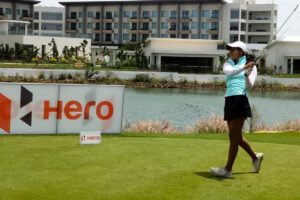
The phrase “teeing ground” is the area in which a player commences the play of the hole also called the tee. However, since the tee is also a small peg on which the ball is placed and also symbolizes the act of placing the ball (teeing it up) or the actual time of the day that you get to kick off, there could be confusion the minds of some as to whether, the word tee is a noun or a verb!
Kenneth Chapman’s book “The Rules of the Green” provides terrific insight into the origins of the tee.
It would appear that origins of the word tee seem to be in another obscure Scottish game called curling where the tee was a target, whereas, the first of the original Thirteen Articles of golf in 1744 said “You must tee your ball within a Club’s length of the hole” signifying that starting point where play is to be initiated.
TOO CLOSE FOR COMFORT
Reading this you may wonder by what convoluted logic those golfers wanted to drive off the next hole within one club length of the hole last played. In the old days, there was no distinction between the fairway and the green, the shepherds just dug up a hole and decided that’s where play ended.
Over the years this distance to the next tee extended to two club lengths, then three, four, then eight to twelve. It wasn’t until 1882 that The R&A decreed, “the ball must be teed within the marks laid down by the Conservator of the Links which shall be considered the “Teeing Ground”. The balls shall not be teed in advance of such marks or more than the two club lengths behind them.” Thus the genesis of the modern day Rule 11 in Golf.
TEEING THE BALL
The actual act of teeing the ball has seen variation as the game developed. In the eighteenth century, the ball was placed on a small mound of sand by far the most traditional method. Indeed a schoolmaster, David Wedderburn, in 1636, recorded in Latin “teaz your ball on the sand”.
Golfers thus took the sand from wherever they could, including from the hole last played! This obviously resulted in the hole size becoming larger leading to a new Rule formed in 1829 requiring new holes to be cut on medal (read tournaments) days, a rule that continues to exist today under Rule 33-2b.
To mitigate this, sand boxes were provided alongside teeing grounds and any visitor to any of the Scottish Golf courses will still see such sandboxes. An interesting Rule is 1834 at Musselburgh Golf Club banned any “Cady who does not carry a bag with moist sand or clay for the tees”.
One other method that was commonly followed then and even today was is creating an irregularity or welt on the turf using the boot or a club. While some clubs frowned upon this practice, it was never discouraged and even today the ball must be played in or on the surface of the teeing ground whether or not created by the player.
LIFT IT UP
The definition of the noun form of the tee appeared to take shape in 1857 with a description “a pat of soil on which the ball is elevated for the first stroke”. Compare this with the very confusing Article 2 of the 1744 Code, which said, “Your tee must be upon the ground” and one can understand the evolution of the ball elevating devices. Indeed, the Equipment Standards Committee of the R&A, today, grapples with scores of requests to approve such devices
TODAY’S TEE
From the 1908 Rule which read “In teeing the ball may be placed on the ground or on sand or other substance in order to raise it off the ground, to the modern Rule which defines a tee as a device to raise the ball off the ground and not be longer that 4 inches plus a few other caveats, the ubiquitous tee has come a long way.
What ever the word tee means, there is little doubt that the first shot on every hole is probably the most important one, endorsed by none other than the great Ernie Els when he said “I plot the par 5s back from the green and make my plan. If I can reach the green in two shots, I’m going to be aggressive off the tee. But if it’s a three-shot hole, the goal changes. You want to put yourself in position to hit your favorite shot to the green.
By: Ishwar Achanta








